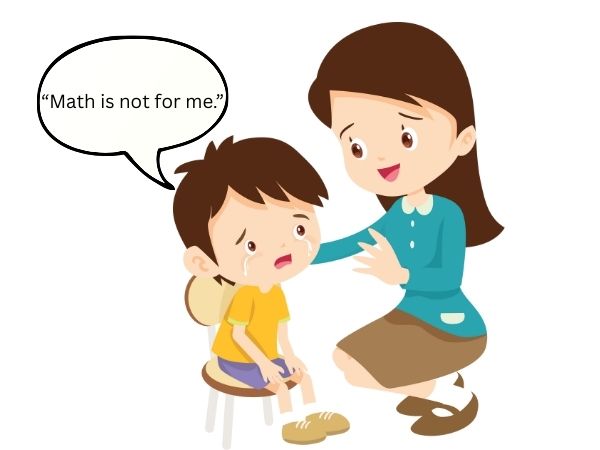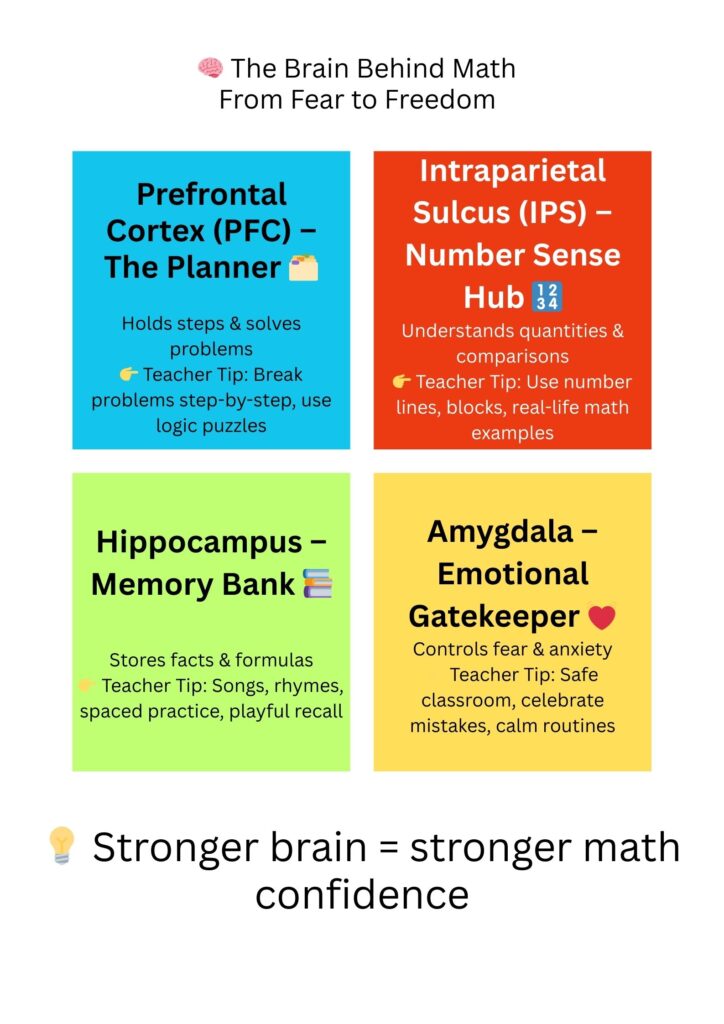A Familiar Fear
As children, many of us remember the feeling: sweaty palms, racing heartbeat, the dread of hearing our name called to solve a math problem on the board. Math, for so many, was not just numbers — it was fear.
But math itself is not the enemy. Fear comes from how the brain — and the classroom — respond to it. With the right teaching, fear can be replaced with confidence and joy.
🧒 Vihaan’s Story
Vihaan was a bright, curious boy who loved stories and cricket. But when math class began, everything about him changed. His voice grew quiet, his eyes dropped to the desk, and if called to the board, his hands trembled.
One wrong answer was enough to bring giggles from classmates and frowns from adults. Slowly, Vihaan began to whisper to himself, “Math is not for me.”

But then came his new teacher, Ms. Kavitha. Unlike others, she didn’t see a weak student — she saw a child whose brain needed support, not scolding. She knew math is not just about memorization. It’s about how different parts of the brain work together like a team — and like any team, each part could be strengthened.
🧠 The Brain Behind Math (Through Vihaan’s Journey)
1. Prefrontal Cortex (PFC) – The Planner
The PFC, behind the forehead, helps with planning and holding steps in mind.
For Vihaan, long division was terrifying because he couldn’t keep track of each step.
Ms. Kavitha slowed him down: “Let’s write every step, one at a time.”
With practice, his PFC grew stronger — and solving problems felt less overwhelming.
2. Intraparietal Sulcus (IPS) – The Number Sense Hub
The IPS, in the parietal lobe, helps understand numbers and relationships.
Vihaan often counted on fingers because he couldn’t see quantities clearly.
Ms. Kavitha introduced number lines, beads, and even cricket scoreboards to explain math.
Suddenly, numbers were not abstract — they were patterns and games his brain could picture. His IPS was being trained.
3. Hippocampus – The Memory Bank
Deep in the brain, the hippocampus stores math facts and formulas.
Vihaan struggled to recall multiplication tables; they slipped away under pressure.
Ms. Kavitha used rhymes, claps, and spaced reviews: “Let’s try it today, and then again tomorrow.”
Slowly, formulas stuck. His hippocampus was building stronger memory pathways.
4. Amygdala – The Emotional Gatekeeper
The amygdala processes fear and anxiety. When it fires too strongly, it blocks learning.
Vihaan’s biggest challenge wasn’t numbers — it was fear.
Ms. Kavitha never laughed at mistakes. She praised his effort, even when answers were wrong. The classroom became a safe space.
As his amygdala calmed, the rest of his brain could finally focus.

🌟 The Transformation
One day, something remarkable happened. Vihaan raised his hand.
His steps weren’t perfect, but his voice was steady. The class listened — and instead of laughing, they clapped. For the first time, Vihaan didn’t see math as a monster. He saw it as a puzzle he could solve.
His fear was replaced by courage, because his teacher had unknowingly strengthened the planner (PFC), the number sense hub (IPS), the memory bank (hippocampus), and calmed the fear filter (amygdala).
🌸 What Teachers Can Take Away
Every child carries their own “math story.” Some freeze, some forget, some fear. But with brain-based strategies:
The PFC grows through step-by-step problem solving.
The IPS sharpens with visuals and real-world examples.
The Hippocampus strengthens when learning is joyful and spaced.
The Amygdala calms in a safe, supportive environment.
When teachers teach with the brain in mind, they don’t just teach math — they rewrite stories of fear into stories of confidence.
💡 The Bigger Picture
As children, many of us feared math. But fear is not math’s destiny.
Math is simply another language of the brain. And when taught with patience, empathy, and the right strategies, every child — like Vihaan — can learn it with joy.
✨ At Pipaltree, we believe no child should grow up fearing numbers. Teachers, with the right knowledge, can make math a subject of courage, not anxiety.
Want to transform your school too? Bring the power of new-age teaching & learning.
Contact us to revolutionize your school’s teaching approach today!
In service since: 2010.
